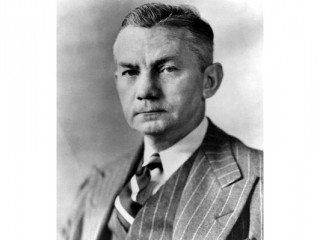
James Forrestal biography
Date of birth : 1982-02-15
Date of death : 1949-05-22
Birthplace : Matteawan, New York, U.S.
Nationality : American
Category : Politics
Last modified : 2011-07-19
Credited as : Politician, U.S. Secretary of Defense,
James Forrestal was born on Feb. 15, 1892, in Matteawan (now part of Beacon), N.Y. His father owned a successful construction and contracting business and had married Mary A. Toohey; James was the youngest of their three sons.
Young Forrestal studied at St. Joachim's Parochial School and graduated from Matteawan High School. He began work as a cub reporter on the Matteawan Journal. When he became city editor for the Poughkeepsie News Press, he realized that he needed a college education to advance his career. He went to Dartmouth in 1911, the next year transferring to Princeton. As a senior he was on the student council and editor of the Daily Princetonian; his class voted him the "man most likely to succeed." However, about 6 weeks before graduation Forrestal left Princeton and never received a bachelor's degree. One of the reasons was that he had flunked an English course and did not make up the credits.
Forrestal worked briefly as a salesman. Then, as a reporter with the New York World, he came into contact with Wall Street society. In 1916 he joined the investment banking house of William Read and Company (soon Dillon, Read and Company). Except for service in the Navy during World War I, he remained with the company until 1940. Beginning as a bond salesman, Forrestal rapidly rose to partnership in the firm; in 1938 he became its president. As a result of several spectacular transactions, he was considered the "boy wonder" of Wall Street.
In 1940 at the peak of his career Forrestal accepted appointment as a $10,000-a-year administrative assistant to President Franklin D. Roosevelt. After 6 weeks in this position he was designated the first undersecretary of the Navy, a post newly created by Congress. During the next 4 years he transformed his post into a nerve center, coordinating the Navy Department's whole procurement and production war effort. His success in expanding the Navy was so great that by the end of World War II the American Navy was stronger than all other navies in the world combined.
On the death of Navy Secretary Frank Knox in April 1944, Roosevelt made Forrestal secretary. In this office for 4 years, he strongly opposed measures designed to make Germany and Japan completely impotent and strenuously objected to sharing atomic information. On the other hand, he supported America's continued effort to sustain the Chinese Nationalists against the Chinese Communists and urged the United States to retain formerly Japanese-held bases in the Pacific. He was an advocate of aid to free peoples and of containment of Soviet influence long before these policies were promulgated in the Truman Doctrine of 1947.
Believing that the oil-producing states in the Middle East were of strategic importance to the United States, Forrestal opposed actions favorable to the creation of the state of Israel in 1947 and 1948. He was also enmeshed in the postwar dispute over unification of the armed services. The Army favored unification, but the Navy feared it. A battle ensued both in Congress and within the government. Forrestal supported greater unity but not complete integration. As a result of President Harry Truman's mediation, the National Security Act, adopted on July 26, 1947, effected among other things the reorganization that created a single Department of Defense, with the secretary of defense given Cabinet rank. Truman's appointment of Forrestal as the first secretary of defense in July 1948 was unanimously acclaimed by the nation's press.
Forrestal gave an impression of toughness and strength. His tight mouth, piercing eyes, and the way he carried himself made him seem more robust than he actually was. In the last months of his life he was mentally disturbed. In March 1949 he resigned as defense secretary, and shortly afterward he was placed under psychiatric care at the Bethesda Naval Hospital. On May 22, 1949, he committed suicide.
















